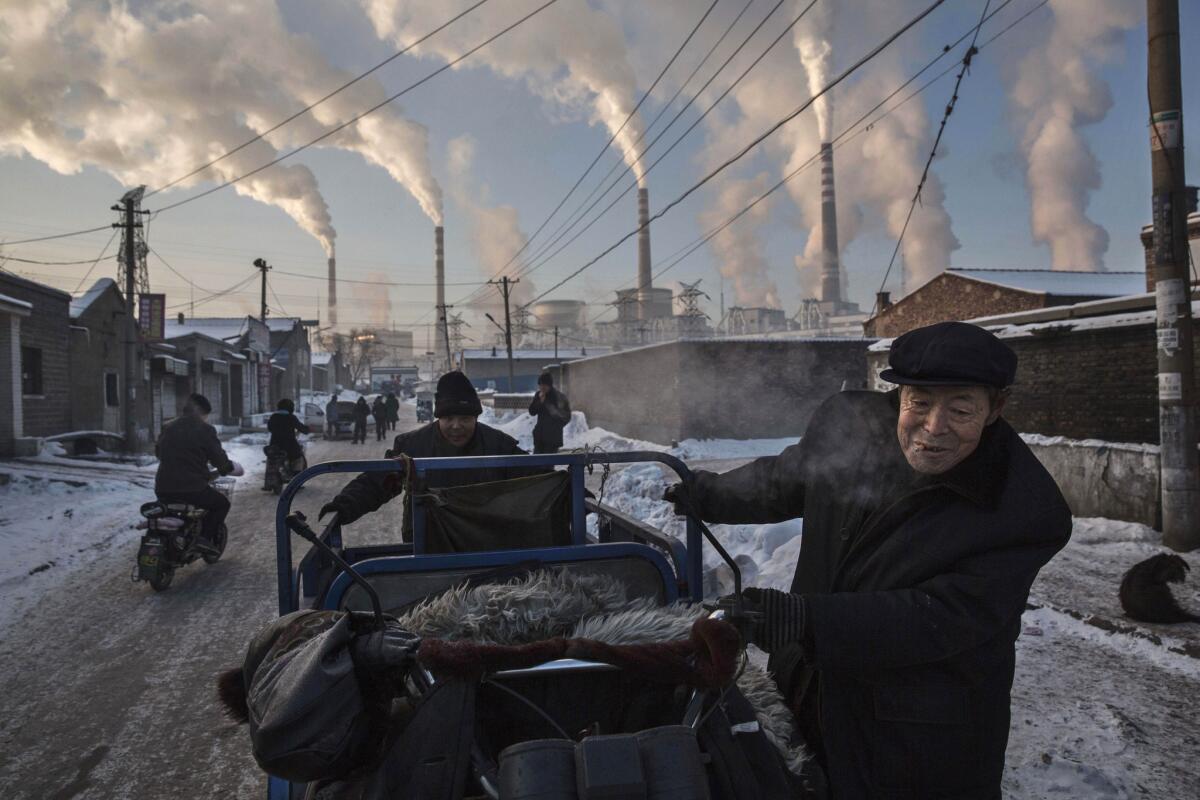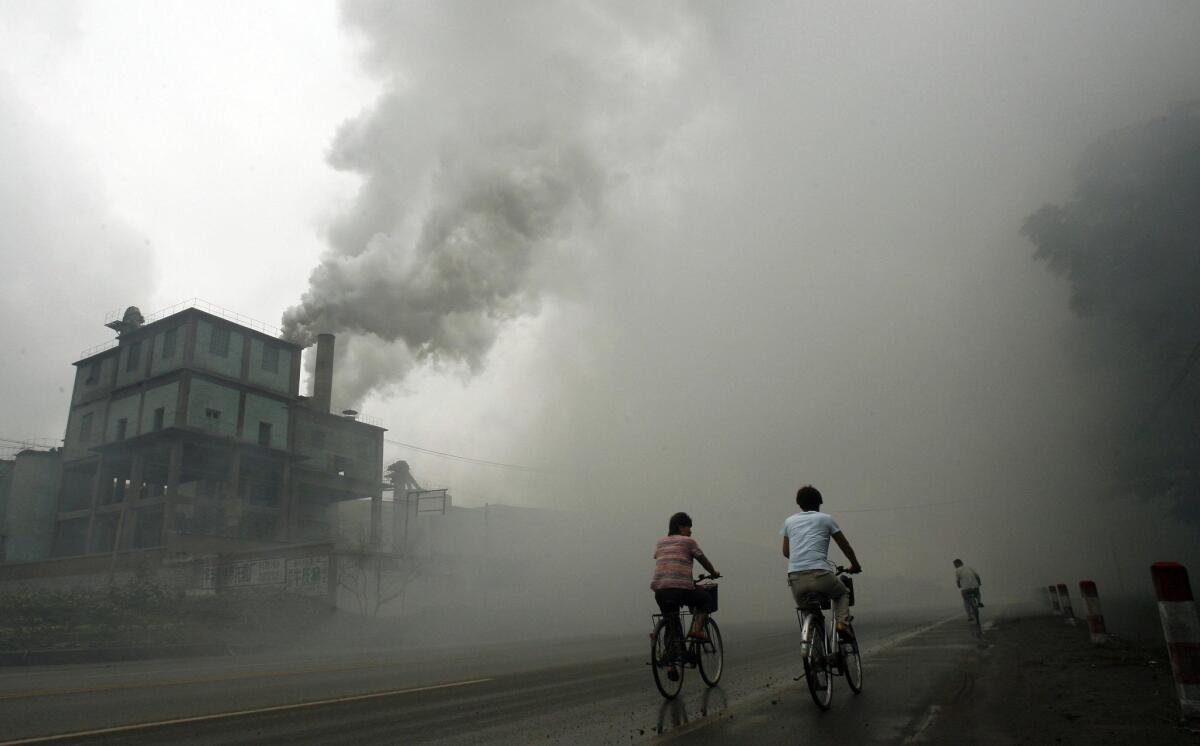China’s blame for global warming is relatively small, study says

Smoke billows from stacks as men pull a tricycle in a neighborhood next to a coal-fired power plant in Shanxi, China.
- Share via
Reporting from BEIJING — Although China’s carbon dioxide emissions have soared in the past 30 years and the country has become the largest greenhouse gas contributor, China is responsible for just 10% of global warming since the pre-industrial era, according to a new study published in the science journal Nature.
China’s share of responsibility for global warming has remained remarkably consistent over the last 260 years or so, the study also found. However, the research suggests that the nation’s efforts to reduce air pollution might actually increase China’s contribution to global warming.
That’s because China may find it easier to cut back on emissions of “cooling” pollutants like sulfate and nitrate aerosols, as compared with emissions of greenhouse gases like carbon dioxide from fossil fuel use.
The report, which examines bio-geochemical, climate and research data from 1750 to 2010, is significant because it offers a comprehensive assessment of China’s contribution to climate change, said Bengang Li, professor and deputy dean of the College of Urban and Environmental Sciences of Peking University, and the study’s lead author.
------------
FOR THE RECORD
April 3, 7:44 p.m.: An earlier version of this article incorrectly stated that the report examined data from 750 to 2010. The data covers the period from 1750 to 2010.
------------
“China’s government didn’t know how much China contributes to the global climate change,” Li said. “So now they know. When they make negotiations with the U.S., with Europe….they can have more quantitative information.”
Li’s team did not publish figures on other countries’ relative contributions to global warming. However, the findings likely put China in second place behind the U.S. in terms of total contribution to global warming, said Andrew Gettelman, a scientist at the National Center for Atmospheric Research in Colorado.
Previous studies put the United States in first place with a contribution to global warming of almost 20%, a figure that scientists say is not surprising given that America has a much longer legacy of emissions because it industrialized earlier than many countries, and on a much bigger scale.
Humans affect Earth’s climate through many mechanisms. One way is by emissions of greenhouse gases and air pollutants. Another is by land-use change -- deforestation for agriculture and urbanization, for instance. Some of this human behavior has a warming effect, and other activities and emissions have a cooling effect. Added together, these effects are known as radiative forcing.
Over the last two centuries, there’s been a net increase globally in warming factors. But each country is different in its warming factors and cooling factors. By examining these various factors and adding up the positives and negatives it is possible to calculate a country’s responsibility for the overall global climate change.

Cyclists pass through thick pollution in 2006 from a factory in Yutian, east of Beijing.
Li’s study is significant because his team examined the factors in a comprehensive way, and accounted for all the drivers of climate change linked to human activity, according to Dominick V. Spracklen, an associate professor of biosphere, aerosol and climate at the University of Leeds in England, and author of a News and Views commentary published alongside the study in Nature.
While carbon dioxide emissions have soared in China, so have sulfate emissions, which have a counteractive, or cooling effect, because sulfate particles scatter light. Li’s quantification of how emissions from carbon dioxide and sulfates offset each other is what makes the study “remarkable,” Spracklen wrote.
China didn’t use fossil fuels on a mass scale before 1900, even as other countries were burning them for industrialization, Li said. Even after China stepped up its use of fossil fuels and began industrializing, land-use changes throughout much of the 20th century kept China from becoming an outsized contributor to global warming. China’s move to start planting trees helped absorb and remove carbon dioxide from the atmosphere.
Around 1980, China’s carbon dioxide emissions from fossil fuels began to soar. But so did its emissions of sulfates. The negative radiative forcing, or cooling, effect of the sulfates offset the positive radiative forcing, or warming, effect of the carbon dioxide, Li’s team found.
To improve air quality, many other countries have slashed their sulfate emissions in recent decades.
As a result, today sulfur emissions are 90% below peak levels in Europe, and around 80% below peak level in the U.S., according to Gettelman, the scientist.
Although sulfate aerosols temporarily mitigate against global warming, some scientists believe countries should take strong steps to curb the sulfur dioxide pollution from burning fossil fuels that forms sulfate aerosols through oxidation in the atmosphere. Sulfur dioxide and other emissions from fossil fuels can have negative health effects, such as exacerbating heart and lung diseases and ailments like asthma.
“There is a huge health burden from this pollution,” said Rachel Cleetus, lead economist and climate policy manager at the Union of Concerned Scientists, a nonprofit science advocacy organization based in Cambridge, Mass.
Gettelman said that since the black carbon aerosol warming and sulfate aerosol cooling offset each other, there would likely not be much effect on climate from reducing them both. “There would be a substantial and immediate positive effect on air quality in China from reducing black carbon and sulfate emissions,” he added.
Li said it would be difficult for China to reduce greenhouse gas emissions if it keeps using coal as its main energy source. The use of more clean and renewable energy is key, he said.
That takes political will and commitment, scientists said.
“All of this is not going to happen without very deliberate policies and that’s true in China as much as it’s true in the United States,” Cleetus said. “As China makes that transition it too will have to make some choices about where it’s going to get its energy from.”
An analysis of preliminary data for 2015 released Wednesday by the International Energy Agency, or IEA, found that China and other countries are making some progress.
According to the agency, emissions of carbon dioxide in China declined by 1.5% as coal use dropped for the second straight year. In the United States, which has undergone a significant switch from coal to natural gas use in generating electricity, emissions declined by 2%, according to the agency.
“Because we’re already reaching a critical point when it comes to climate change and global temperature increase, we’ve got to do a lot more a lot faster,” Cleetus said. “The U.S. and China are both in a position to play a strong leadership role on this.”
More to Read
Sign up for Essential California
The most important California stories and recommendations in your inbox every morning.
You may occasionally receive promotional content from the Los Angeles Times.














